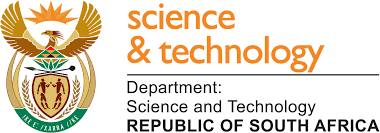

EcoSUN Sustainable Village - an integrated approach for sustainable settlements Overview
Progress in the development of sustainable human settlements especially in regions suf-fering from poor infrastructure, can be achieved best through the integrated application of green technologies based on local and solar resources, appropriate town planning and design of dwellings, oriented towards the benefit of the people, social activities, business development and income generation.
EcoSUN Sustainable Village approach comprises an infrastructure package that combines practically proven technology modules of ecological sanitation (Ecosan), safe drinking wa-ter supply, renewable and solar energy use (SUN), and housing, in an innovative manner (EcoSUN) to create sustainable settlements for the people.
Central is a technology and community hub to which houses are directly connected for water related activities. This allows privacy in hygienic activities in the people's homes, and centralized community oriented activities. Grey water is treated and recycled for toilet flushing and laundry. Safe tap water is prepared centrally or in point of use systems. Solar related warm water and warm air preparation are preferred energy options substituting fossil fuels at good a cost-benefit ratio and support rational energy usage. Architectural design after requirements of green technologies and demands of people, is a cornerstone and results in construction plans for local circumstances.
A consortium of German and RSA institutions is piloting EcoSUN during regular building activities in the Camdeboo Municipality, as part of the German-South African scientific co-operation, funded by the German Ministry of Education and Research (BMBF), fund num-ber 02WCL1357A-E, and managed by the Project Management Agency PTKA-PFT at Karlsruher Institut fuer Technologie (KIT).
1. Challenges of the settlement program in RSA
In South Africa, the housing situation of the formerly disadvantaged people has been considerably improved through the RDP program when 2.4 million dwellings were built as part of the largest in the world housing program. Nevertheless, more houses are in demand; the number is estimated 2.3 million. However, there is a variety of new challenges the housing program is faced with, amongst which access to basic services of water and sanitation, energy, and waste management, and infrastructure of rural settlements including informal settlements, are high ranking and have to be combined with quality and cost issues of building, alternative building methods and materials, as well as training and education for people to improve maintenance and repair, and the challenges of climate and resource protection by means of reduced material input and lower carbon footprints, as part of the green agenda. Moreover, there is also need in houses at a level higher than RDP (RDPplus) for people who do not qualify for RDP due to their higher income. RDPplus means e.g. more space (up to 70m2), and installation, on own expense of the users, of solar devices, point of use water cleaning systems, etc. It is also necessary to remember that people have their own tradition to contribute to the building of houses, or are willing to extend their units in case their families grow or a business to be operated on their own property.
2. The EcoSUN Sustainable Village approach
Responses to the challenges include the strategy to focus on the development of self sustaining human settlements instead of houses only, which means, e.g., the integration of village centers, children's playgrounds, and business and income generation opportunities for the people. Green technologies are considered a center stone of further development: With respect to the energy there are several options such as the usage of locally produced renewable energy instead of energy from the national grid and its dependency on coal, biogas technology to combine energy and waste management, use of solar energy for room and water heating through solar collectors. Ecosan technologies are proposed for water supply and sanitation including grey water recycling, multiple water use, use of waste water ingredients, such as minerals from urine, etc. The EcoSUN Sustainable Village approach fits well into these needs.
It consists of technological and socio-economic related features. As the essential techno-logical part of EcoSUN, an infrastructure package is established consisting of four priority components: i) ecological sanitation ("Ecosan"), ii) waste management, iii) renewable and solar energy use ("SUN"), and iv) modern design principles of town planning and house design, and combined as EcoSUN technologies (see figure 1) aiming to create sustainable settlements for the people.

Figure 1, General technological components of the EcoSUN concept
The package makes use of, further develops and/or adapts, to the specific conditions in RSA as a whole and in the communities, internationally proven technologies. It includes, as a partly novel central element, a specially designed Multipurpose Centre (MPC). Figure 2 represents an overview of the principle technological options applicable in the EcoSUN Sustainable Village.
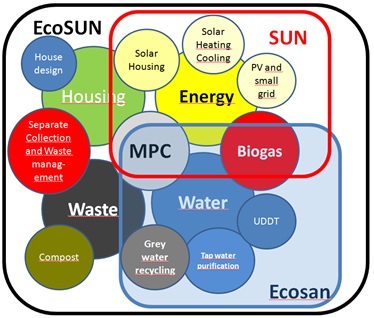
Figure 2, Principle EcoSUN technology modules
It is the intention of the EcoSUN approach that all technologies will become combined in a sustainable manner only after the concrete situation at the construction site of the settlement. It is especially tailored to the situation of urban villages and/or transforming or upgrading of informal settlements in regions characterized by poor infrastructure.
The socio-economic focus is on creating social change by consideration of the real needs of the people under the given economic constraints. Essential features are public participation, technology and knowledge transfer as part of education and training, development of business opportunities including service teams for maintenance and improvement of the existing demonstration units and its rolling out in other Municipalities. Privacy and dignity of people and their life are high ranking goals, as well as principles of African culture such as Ubuntu principles of cooperation and neighborhood, or the Zenzele principle of self-reliance, self-help and self-confidence (Dewar, 2015), both to get people involved in all steps of the process. Moreover, the demands will be met of better resource economy and the usage of local or regional material and energy resources, as well as a smaller carbon footprint for improved climate protection.
Through the use of innovative sanitation technologies (Ecosan) for RDP houses and set-tlements the fresh water demand as well as the waste water disposal are both covered at the highest sanitary level. With respect to this the water consumption will be reduced in a sustainable way and the reuse of valuable components of waste can be organized ecologically as well as economically. In addition, using renewable stocks will create a cost-efficient and sustainable way to provide energy to the people. This, as well as the design of the houses and the settlement, adapted to the predetermined local environment, will improve the overall living conditions. The development of an upgraded version of the low-cost houses will open the program for higher income groups who do not qualify for RDP level, such as teachers, business people or administrators, and for which until now offers are lacking.
These challenges of EcoSUN Sustainable Village approach can be highlighted by the following proverbs:
• Create settlements and homes together with the people
• Ownership attitude and buy-in of people essential for success
• No project without education and training programs
• Use water reasonably, adapt water usage to the quality needs
• No drinking water for flushing toilets at all
• Don't waste any material - Turn waste into value
• Consider local resources first - human, material, energy
• Let sun work for you - turn the village into a power plant
• Allow and encourage people to contribute to their own homes
3. EcoSUN Technical Arrangement
A typical EcoSUN Village is created in such a manner that a number of about 100 dwell-ings are arranged around the Multipurpose Centre (MPC) that is a central building to which they are attached, individually or in combination with others, through water pipes - see Figure 3.
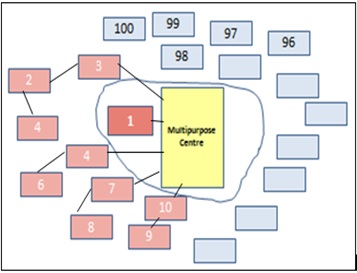
Figure 3, Principal arrangement of an EcoSUN settlement
Details of the connection of the Multipurpose Centre with the individual houses, as far as it refers to sanitation, are presented in figure 4 for one house, as an example only.
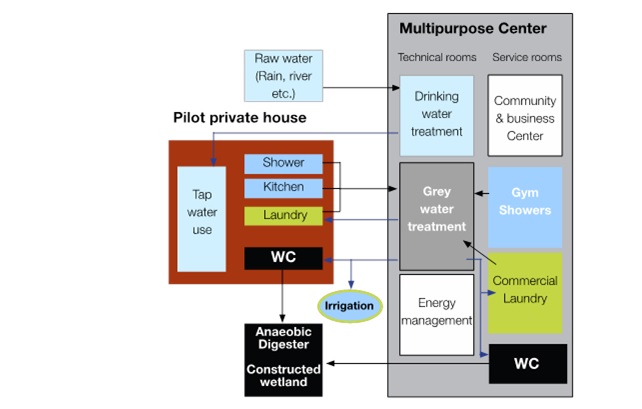
Figure 4, Multipurpose Centre as combined with one individual house
Tasks of the MPC and the piping system
The tasks of the Multipurpose Centre in the EcoSUN system are twofold: Firstly, it is a "usual" Multipurpose Centre (or Facility) - and offers a range of services in one location (CSIR, 2005), and may comprise rooms for communal services, education, training or sports activities etc., and/or commercial activities such as a laundromat, and is equipped with sanitation devices such as showers and toilets which are necessary in case of meet-ings, or sports activities, by hygienic reasons.
On the other hand, the MPC is the shelter for the installations of the EcoSUN related technical systems, and is, fully or in part, depending on the level of technologies applied, equipped with facilities for grey water treatment, tap water production, and devices for en-ergy management, such as heating and cooling systems, storage tanks for warm water, and photovoltaic cells for power storage.
The piping system is an essential part of the EcoSUN system. Its function is to transport all kind of used water except toilet water, summarized as grey water, from the individual houses to the MPC from where it is recycled as high quality service water, after treatment in a grey water treatment plant, and which allows the people to use all water related ser-vices individually in their own homes so that a high level of privacy for the families will be guaranteed. Only the technology is centralized in the MPC.
This situation is in contrast to the Communal Waterhouse approach (Soyez, 2015), where services are centralized in a building, were people can use it, instead of using the services in their own flats. This kind of MPC is now considered an interim solution for improved sanitation until a final solution will be realized.
4. Technological details of the core elements of the EcoSUN system
As part of the EcoSUN system a variety of technological modules are considered. Which one will be applied will depend on the conditions on the concrete site. Only some core elements will be described in detail.
4.1. Ecosan and tap water preparation technologies
The sanitation related mantra of EcoSUN is simple and well understood however not yet applied generally: Use water reasonably - adapt water usage to the quality needs. No drinking water for flushing toilets. "Water demand has traditionally been met with water from the best available sources, however, such sources are limited, and more important, not all uses require the same water quality", stated RSA Water Research Commission (WRC, 2013). Water for flushing toilets which amounts to up to 40% of domestic water usages can be substituted by water which does not qualify for drinking and other human uses (Ilempobade, 2012). Amongst that recycled water is a main source. On a wider scale, recycling means that more high quality sources will be available for higher quality uses, and reduced waste water amount may result in smaller waste water treatment plants, which both means reduced resource needs and lower costs.
Grey water and its treatment and usage
One alternative source of water for non-human usages is grey water which is "wastewater from showers, baths, spas, hand wash basins, laundry tubs, and washing machines and may or may not include wastewater from dishwashers and kitchen sinks but definitely excludes toilet wastewater" (WRC, 2013). Grey water usage is therefore recommended by the RSA National government, in accordance with activities in overseas like Germany, Sweden or the US, and is a core element of the EcoSUN Sustainable Village concept which is most important in regions suffering from bad quality of drinking water.
In RSA grey water usage currently means untreated grey water, e.g. for toilet flushing or irrigation for which applications directives are under development (Rodda, 2011, WRC, 2013). In contrary, the EcoSUN concept involves a grey water treatment step before any usage. The result is co-called recycled or service water - no drinking water by law, but well suited for all non drinking purposes.
There is a number of technologies available for grey water treatment so that the best solu-tion can be selected for specific applications which approach is also recommended by the Water Research Commission. In case of the EcoSUN Sustainable Village the AQUALOOP system of grey water treatment (www.intewa.de) is intended for application. Its performance fits well into the needs of high quality levels and covers the needs of the European Union Bathing Water Directive (EU, 2006) or the British Standard and is well suited to treat domestic grey water as expected from the households of RSA settlements.
The technology includes filtration and bioprocesses only, no chemicals needed. Fresh grey water passes a separator and a pre-filter before the bioreactor where the biological degradation takes place by means of natural micro-organisms. After micro-filtration it can be stored and pumped to the users. Rain water can be channeled into the system before the membrane station.
The scheme of the technology as applied in EcoSUN is shown in figure 5: Grey water from kitchen, bathroom and washing machines is collected, transported through pipes to the treatment system, and the recycled service water is used for flushing toilets and laundry purposes, or for irrigation.
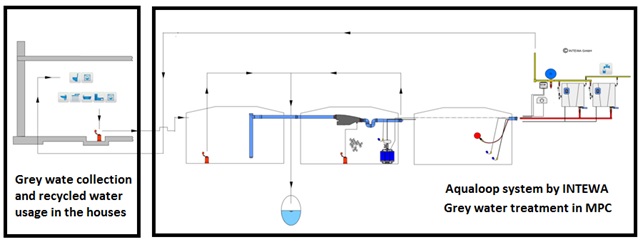
Figure 5, Grey water treatment as part of the EcoSUN approach (www.intewa.de)
Black water treatment
Black water means the effluent from flushing toilets and is treated separately. As an alter-native to a conventional aerobic waste water treatment station, anaerobic digestion may be applied which results in energy rich biogas as an extra benefit. In several waste water works in RSA, vintage types of bio-digesters exist which are not operational due to longer down time and lack of maintenance. In case they can be upgraded, these devices are worth considered a part of the EcoSUN solution. In all other cases investment costs are too high, operation is expensive, trained personal needed, and it is then not a preferential approach therefore.
As a less sophisticated, though by no means simple, alternative, constructed wetlands can be considered where black water is treated in an open biological system, often named reed bed. Bio-filtration, removing of sediments, decomposing of organic pollutants and uptake of heavy metals, are the process results. Technologically, constructed wetlands form a sequence of water bodies which, depending on the design, allow even to tread on the surface of such areas. Therefore, they can form an integrated part of a settlement and in case of proper operation they contribute to an improved micro-climate. It is also a benefit that the systems work locally and need no long distance water piping. This type of black water treatment is considered part of EcoSUN settlements.
Under the condition of extreme water scarcity, water free toilets can be a matter of choice, and a variety of such systems exist including the Urine Diversion Toilets (UDT) which are characterized by good hygienic standards and extra benefits through production of mar-ketable mineral or organic fertilizers. However, UDT is not first choice of the users, and the combination of housing architecture and UDT design pose a variety of challenges if operated together with solar air heating systems.
Tap water preparation
As part of the EcoSUN system, locally available water sources will be treated to a quality standard ruled by law, considering two options: I) a centralized treatment facility and ii) a point of use system in the households. Another specific task is cleaning of rain water in collection tanks which impose the risks of diseases over longer periods depending on the rainfall intensity and duration of dry periods.
As a central water preparation unit the EASY FILTRATION system (www.evers.de) will be used which is characterized by specially conditioned Anthrazite based filter material and a reasonably constructed re-flushing system needing small amounts of energy only. A plant, as given in figure 6, for a capacity of 20 kL daily, will become part of the MPC design.

Figure 6, Tap water preparation reference plant in Uganda (www.evers.de)
4.2. Renewable and solar energy
Energy supply is another indispensible service to people in modern settlements and forms a key feature of EcoSUN sustainable village concept. The focus is on reasonable energy management, and its provision from renewable resources and from sun, making solar radiation a main source as an alternative to the provision through the central grid. Let sun work for us is one of the central ideas of EcoSUN.
Preferred solar energy usage is for the production of heat which is relatively cheap and reliable a kind of usage. On the other hand, since electricity is indispensible in every household for modern daily life, solar power must be taken into consideration. In the EcoSUN approach we follow the mantra: Make the village a power station.
Solar heating systems
Use of solar energy for water heating is well established worldwide and also in RSA its application is growing substituting electrical geysers. The other option is to generate hot air which can be used for room heating in the cold season directly, or to heat up water indirectly. As a more sophisticated design the combined approach - room heating and/or warm water preparation - is preferred in the EcoSUN system.
Solar power
Electrical power is an indispensible part of energy supply as for lighting, operation of TV and radio, and machinery etc. Power from sun is well known worldwide and considered the future energy supply independent of fossil fuels and therefore climate neutral. However, even though the substantial decrease of costs, during the last decade, for investment and operation, solar power is still expensive. In the EcoSUN concept a specific solution is proposed: Instead of placing solar modules separately in a plant outside the village, fit the modules on the roofs of the houses - The village the power station. In case the amount of power produced exceeds the needs of the house, a certain amount can be fed into the national grid. As an example: 100 houses equipped with a roof area of about 100 m2 each will result in more than 1 MW electrical output from which only a part is needed in the village itself and the bigger part sold to ESKOM. However, a pre-condition is that a feed-in-tariff would be paid. In the EcoSUN approach the houses will be pre-equipped with appropriate roof structures making it possible to apply solar cells as soon as the financial conditions were met.
4.3. Town planning and house design
Modern town planning and house design for human settlements require the full consideration of principles of sustainability which means best practices in terms of technology and architecture, as part of an integrated approach towards best solution regarding community life, effects on nature and climate, as well as economy, etc.
Under the technical point of view, each kind of settlement can become completed by addi-tion of EcoSUN modules as described, or, vise versa, EcoSUN components can be at-tached to an existing settlement as add-ons. However, better results will be achieved in such a case that the settlement is designed, from the very beginning, under full consideration of EcoSUN technology modules and as a complete system. Solutions for that kind of approach are developed and applied in the EcoSUN system.
The need of an integrated approach results from the fact that, the components must be adjusted to each other, and some of the technologies can only work efficiently if some specific pre-conditions will be met, e.g. amongst others: To realize the general concept the Multipurpose Centre need to be situated preferably central so that piping is shortest; if a constructed wetland is foreseen there must be enough space in or nearby the settlement; recycling of water needs a double piping system; the energy yield of a solar power system is best if roofs are oriented East-West or North depending on the system used.
Architecture for EcoSUN has to consider good architectural principles, such as described in the National Housing Code (Code, 2001) and the Guideline for human settlements (CSIR, 2005), and novel construction material. Moreover, it has to observe social and eco-nomic requirements as well as RDP principles. Both the houses and the MPC must be designed after the wishes and the necessities of the community and the individuals who will live in the dwellings, considering their cultural background. Obviously it is indispensible that the public participate in all activities including training and education for their buy-in and ownership attitude as well as understanding of future maintenance needs.
Some features regarding the design of the dwellings under EcoSUN circumstances see table 1.
Table 1, Choice of EcoSUN design features
|
Feature |
Reasons, expected results, examples |
|
Settlement area inside the village structure |
Making use of existing area instead of newly developed area consuming settlements, consideration of existing buildings, reduced infrastructure need |
|
Flexible floor plans |
Floor plan adjusted to easy alterations of the buildings by the owners - details see below |
|
Plot area 200 m2 |
Typical land requirement under limited land resource |
|
Appropriate positioning of the dwellings after principles of National Housing Code and EcoSUN needs |
Energy related: East-West facing of roofs preferred as pre-condition of optimum sun harvest over day or North facing, dependent on the roof design and the position Community related: Semi-detached houses positioned at the borders of plots |
|
Mixture of detached and semi-detached houses, three houses complexes |
Lower land requirement, reduced material, neighborhood aspects to be considered |
|
Houses equipped with showers, flushing toilets, supply of tap water and service water for flushing and laundry, grey water collection from showers, laundry and kitchen sink |
Double piping system, connected to a grey water treatment facility, warm water in case of solar geysers installed |
|
Flushing toilet equivalent systems if necessary |
Urine diversion toilets as an alternative at the same hygienic and service levels |
|
Double storage building |
Land considered a scarce resource, land requirement reduced, family and more generation approach |
|
Water tank positioning close to or as part of the building, gutters connected |
Rain water collection using 2.5 kL plastic tank |
|
Roof structure pre-installed for solar power and improved ventilation through solar air systems |
Solar power and solar air systems of appropriate area |
|
Waste collecting bins attached to the house or integrated into the hedge or fence nearby the street, organic waste management on-site |
Home composting facility on the plot, 10 m2 area |
|
RDPplus: Extended ground floor area, better equipped |
Housing for people who do not qualify for RDP, area e.g. 75 m2, improved heat insulation, solar power panels, solar air conditioning, point of use water cleaning systems |
Amongst the features regarding the design of the dwellings it is specific that owners of houses should become encouraged and enabled to enlarge or finish their homes, e.g. in case the families grow or other circumstances of their lives change. It seems that the basic structure of the RDP type houses do not really support this aim as many examples of poor quality additions or alterations to such buildings show (see figure 7).

Figure 7, Typical unfavorable alterations of a RDP house
Therefore, a ground plan alteration proposal for RDP dwellings with an area of 40 m2 was developed in the first phase of the EcoSUN project. In its basic version, two parts of the house are shifted (see figure 8, leftmost), which gives the chance to form two extra terrac-es (see second from the left) creating opportunities for outdoor activities and/or shadow-ing. If more sheltered living space is needed the terraces can be transformed into rooms, and in case of RDPplus the ground floor can be increased easily (see figure 8 right).
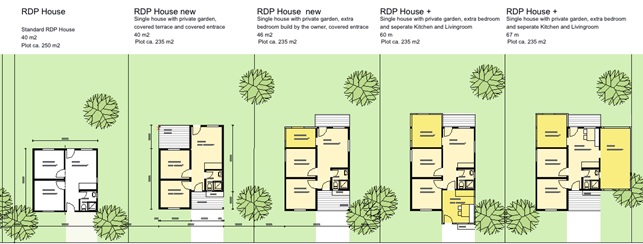
Figure 8, Examples of alterations of a typical RDP house for extra rooms
4.4. Public participation and training
A basic challenge of technology transfer is education of users and operators of plants. To guarantee long term maintenance and operability, education is therefore in the focus of the EcoSUN approach. During the project a number of technicians shall be educated through learning-by-doing and by regular courses as was realized already during several building projects (see Figure 9). A teaching manual will be developed based on German educational schedules for handicraft workers and RSA certification needs. Courses will be held in Germany at the education centre of the Chamber of Handicrafts. Educated person will get basic knowledge for their own business development as well as trainer’s abilities. Cooperation with FET Colleges is foreseen.
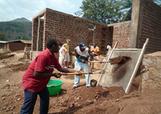
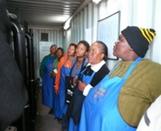

Figure 9, Builders' training, basic education and maintenance in communal projects (from left)
5. State of the implementation in RSA of the EcoSUN Sustainable Village concept
EcoSUN Sustainable Village will be demonstrated and piloted in the Camdeboo Local Municipality in EC Province, as the result of a long term consultation and decision making process which also considered the willingness of the Municipality to support such kind of project as part of their IDP. The realization started in 2016 and is considerably funded by the German government's CLIENT initiative which is part of the German-South African scientific and technological cooperation. A number of seven German institutions and companies as well as their RSA partners are involved (see www.ecosun.com.de).
Camdeboo is a Category B Municipality with a plenary type Council where all powers re-side in the full Council which is in line with Sections 155 and 156 of the Constitution (Camdeboo, 2016). A variety of features which are essentials of the EcoSUN approach, such as development of infrastructure, local economy, institutions and community devel-opment, are the High Level Development Priorities that form the foundation of Camdeboo Municipality’s IDP. In the period 2014-2015 the municipality has been able to plan for the construction of 1029 RDP houses for which the municipality has availed land for and in-stalled the infrastructure. Moreover a suitable site where a Multipurpose Centre will be erected was identified. This centre will be hosting a community centre, library, clinic and crèche. The project is now in the final stages of approval in the procurement processes of the Department of Human Settlement (Camdeboo, 2016).
EcoSUN project realization is intended in, and ongoing town planning prepared for, the Kroonvale Township in Graaff-Reinet where a total of about 80 houses could be built, from which 29 are on the list of the Municipality, and a number of 10 which will form the core of the EcoSUN Sustainable demonstration village and will be equipped as part of the project.
The settlement is an area from which a wetland forms one border, and which is on the three other sides bounded by small roads which means that good infrastructure already exists. The wetland needs special consideration under the environmental point of view, and it offers good possibilities of landscape planning. On the site, a building exists which is presently used as a Skills Hub, and it is intended to use it, after alteration, as a Multipur-pose Centre which may contain the grey water treatment plant and the drinking water treatment facility - both visible from outside as for demonstration -, but also community rooms for various functions.
With respect to the position of the MPC in Kroonvale it is to be mentioned that, in an ideal type of EcoSUN village, the MPC would be the very centre of the village, however in the given situation, the MPC is situated on the border which means that the settlement forms a kind of a segment of the ideal structure, and can be completed later making the MPC central.
The plots are about 200 m2 each and on every plot single or semi-detached houses of different shape, orientation, and roof structure will be erected depending on the preferences of the people. Two or more houses combined will give chance for larger families to life together and to use the area more economically. Activities on the plot, such as for gardening, composting of organic residues, playing grounds for the kids, etc., will depend on the owner's intentions. The homes will be equipped after RDP standards, however with double piping for service water for flushing toilets and treated drinking water as an extra feature essential for EcoSUN. Solar devices and point of use water treatment systems will be added in case of a house at the level of RDPplus.
The settlement layout is completed by a waste collection site where containers for different types of waste, as part of a waste management business, are placed. Another part of the settlement is planned as a constructed wetland for the treatment of black water after its collection and pre-treatment (see figure 12). Each of the houses is connected to the MPC through pipes for collection and recycling of grey and service water, resp., and for tap water after treatment. The settlement may be completed by a business area.
An overview of the settlement ground plan is given in Figure 12. The start of the building activities is scheduled for early 2017, and the completion of the EcoSUN Sustainable Vil-lage settlement for 2018.
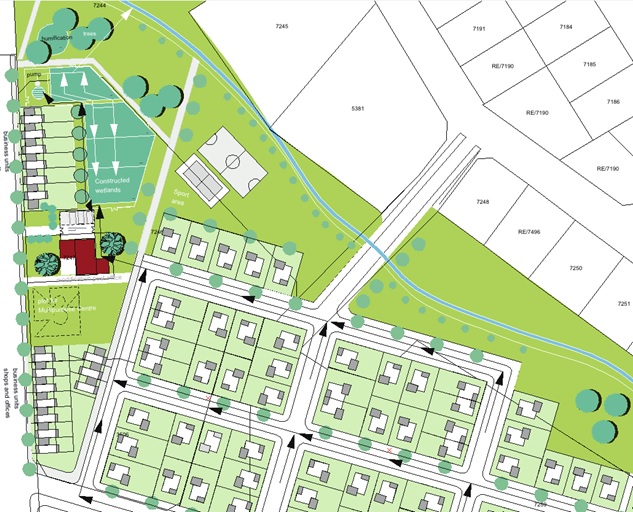
Figure 9, Proposed town planning scheme (with blackwater piping and constructed wetland)
Literature
Camdeboo, (2016). Camdeboo Local Municipality 2014/15 Annual report. Graaff-Reinet: 2016.
CSIR (2005). Guidelines for human settlement planning and design. Pretoria: CSIR, 2005. Soyez, K. (2009). Communal Water House, Proc. Int. Conference and Exhibition on Water in the Environment, Stellenbosch, March 2-4, 2009.
Dewar,D. and Andrews, P. Housing manifesto 2015: Bottom-up democracy in practice. Private communication, Cape Town: 2015.
EU (2006). EU directive for bathing water. Directive 2006/7EC of the European Parliament and of the Council of February 15 2006 concerning the management of bathing water quality and repealing Directive 76/160/EEC. Jo L 64, 4.3.2006.
Ilempobade, A. Olanrewaju, O. and Griffioen,M. (2012). Greywater reuse for toilet flushing in high-density urban buildings in South Africa: a pilot study, WRC Report No. 1821/1/11, Johannesburg: January 2012.
Nolde, E. (2016). Roof water farm: A multidisciplinary approach to integrate waste water reuse with urban agriculture, Proceedings Water efficiency conference, 2016 (in press)
Rodda, N., Carden, L. Armitage, N. and Plessis, H. (2011). Development of guidance for sustainable irrigation use of greywater in gardens and small-scale agriculture in South Africa. Water SA 37(5), WRC 40-Year Celebration Special Edition 2011, pp. 727-737.
Soyez, K. (2009). Communal Waterhouse. Proc. Int. Conference and Exhibition on Water in the Environment, Stellenbosch, March 2-4, 2009.
Soyez, K. (2015). Communal Waterhouse. Final report prepared for German Ministry of Education and Research (in German), Beiträge zur ökologischen Technologie, Volume 14. Potsdam: 2015. https://www.youtube.com/watch?v=CVQG31ma6_U
WRC (2011). Strategic management of greywater in the non-sewered areas of South Afri-ca. Water Research Commission, Pretoria: WRC Project K5/1524
WRC (2013). Greywater reuse for toilet flushing in high-density urban buildings in South Africa: A pilot study. Pretoria: WRC Technical Brief, June 2013
Prepared by EcoSUN project team Dieter Baier, Stephan Evers, Herbert Markert, Barbara Mohren, Erwin Nolde, Oliver Ringelstein, Konrad Soyez

